Sweet wine, once prized as a luxury item, has fallen somewhat out of fashion in favour of its dry relations. Sweet Italian wine, however, should induce you to taste some of the nectar that many snub. Italy produces a vast array of sweet wine from indigenous varieites from the very north of the country right down to the rocky outcrop of Pantelleria, located between Sicily and Africa. As with dry Italian wines, regional specialities abound, ensuring that there is always something new to discover. A range of styles ensure that there is something to suit your mood, palate or special dessert.
Sweet Italian wine can be categorised as sparkling (spumante or frizzante), naturally sweet passito (produced from shrivelled grapes) or fortified (with grape spirit added to aid preservation and increase the alcohol level). It may come in red, rosé or white.
Sweet sparkling wines are produced by artifially halting the fermentation process by chilling down the fermenting juice to retain some of its natural sweetness.
Popular examples include Asti Spumante and Moscato d’Asti from Piedmont. Asti Spumante, or simply Asti, is fully sparkling with notes of orange and dried apricots. Often enjoyed as an aperitif, it may be served with locally cured Piedmontese meats or hard cheeses. It also works well paired with a light, fruity dessert. Its sibling, the gently sparkling Moscato d’Asti, also made from Moscato Bianco, pairs well with mild cheeses or the local ’torta di nocciola’, a roasted hazelnut cake.
Piedmont is also home to Brachetto d’Acqui, a red sparkler with floral and strawberry aromas, delicious with fresh berries or giandiua, a sweet chocolate with hazelnut paste from the region’s capital, Turin.
Lambrusco, a light sparkling red or rosé from Emilia-Romagna is often looked down on, but ’amabile’ or ’dolce’ versions are delightful with the local peaches and nectarines, or chestnuts, both of which even have their own PGIs.
Passito wines are produced practically everywhere in the country, from grapes dried by the ’appassimento’ process, that is air dried on the vine or laid out to dry on straw mats either in the sun or in well-ventilated buildings. This concentrates both their flavours and sugar content resulting in lusciously sweet dessert wines.
Passito di Pantelleria is produced from sun-dried Zibbibo grapes, the local name for Moscato d’Alessandria. This velvety, amber wine has flavours of apricot, peach and raisin developing into sweet figs, honey and dried herbs with age. Pairs well with Sicilian desserts like cannoli or cassata or with pungent cheeses. Sicily’s hot climate is perfect for sweet wine with other takes on Moscato produced in Noto and Siracusa. Malvasia delle Lipari’s sweet apricot flavours also work well with foie gras.
Central and northern Italy also make outstanding sweet Italian wine with the nutty oxidised Vin Santo, made from Trebbiano and Malvasia, finding its spiritual home in Tuscany, although it is also produced in Umbria, Veneto and Trentino. ’Occhio di Pernice’ (eye of the partridge) from Montepulciano is made predominantly from red Sangiovese grapes. Vin Santo gives us the most famous sweet Italian wine pairing – it’s usually served with cantuccini, hard almond biscuits, dunked in it to soften them and soak up the wine. The Veneto’s most prominent contributions to passito wines are Recioto della Valpolicella and Recioto di Soave. The dense, red Valpolicella makes a delicious accompaniment to Tiramisù and golden yellow Soave pairs well Verona’s Pandoro or semi-aged cheese like Monte Veronese.
Finally, we shouldn’t forget the nutty, solera-aged fortified wines of Marsala and Vernaccia di Oristano in Sardinia, which although considered dessert wines, were traditionally served as aperitifs with local cured meats.
At Wine Paths, our team of local experts can help you get to grip with the luscious treats that are sweet Italian wine.
If you're interested in one of our Italy Wine Tours, please visit this link.







